-
RESEARCH01-01-2017
Promoting oral care in the preschool child: effects of a playful learning intervention
Revista Brasileira de Enfermagem. 2017;70(3):519-525
Abstract
RESEARCHPromoting oral care in the preschool child: effects of a playful learning intervention
Revista Brasileira de Enfermagem. 2017;70(3):519-525
DOI 10.1590/0034-7167-2016-0237
Views0See moreABSTRACT
Objective:
To compare the number of appropriate behaviors for tooth brushing before and after a playful learning intervention with preschool children.
Method:
A quasi-experimental, quantitative, before and after study design was conducted in an early childhood educational institution, with children between three and five years of age. The intervention consisted of three meetings with educational activities about tooth brushing, whose outcome was evaluated by means of observation of ten behaviors suitable for tooth brushing.
Results:
Forty-four children participated in the study. The mean of adequate behaviors was 4.4 before the intervention, and 8.5 after the intervention. A significant increase in the adoption of appropriate behaviors for tooth brushing (p <0.01) was identified.
Conclusion:
Nurses can enhance oral health promotion actions with preschoolers in preschool institution using playful learning interventions
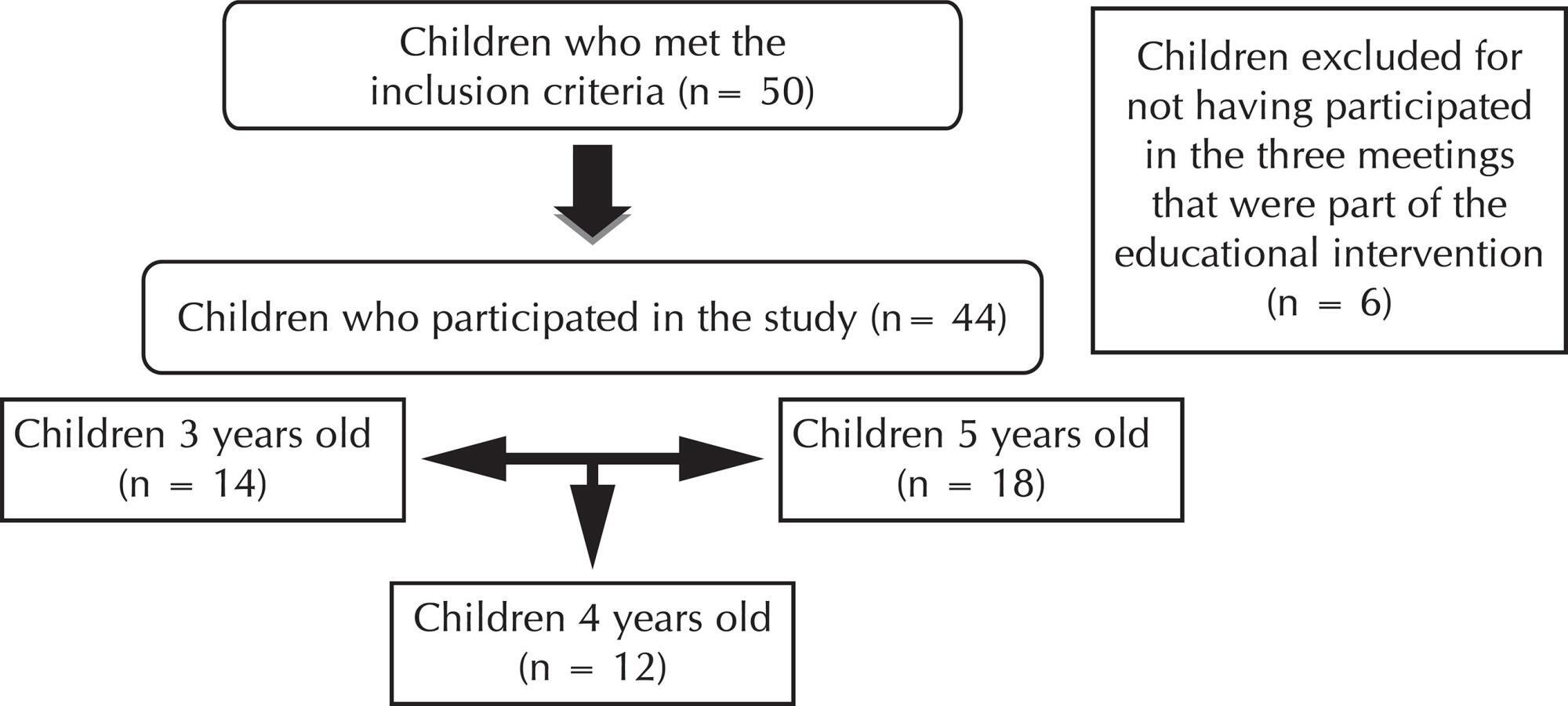
-
RESEARCH01-01-2017
Violence against children and adolescents: the perspective of Primary Health Care
Revista Brasileira de Enfermagem. 2017;70(3):511-518
Abstract
RESEARCHViolence against children and adolescents: the perspective of Primary Health Care
Revista Brasileira de Enfermagem. 2017;70(3):511-518
DOI 10.1590/0034-7167-2016-0471
Views0See moreABSTRACT
Objective:
To analyze the care provided by Basic Health Units (BHU) to families involved in domestic intrafamily violence against children and adolescents.
Method:
Qualitative research, based on the Paradigm of Complexity. Data collection was performed with 41 professionals through focus groups and semi-structured interviews.
Results:
The following categories emerged from data analysis: ‘Everything comes here’, which reflects the legitimate place of BHUs for the population and the actions taken to build care for families; and ‘We only do what is really necessary’, which brings the look to violence still based on the positivist and biomedical paradigm.
Final considerations:
The model of understanding and construction of work processes in the BHU is structured in the aforementioned paradigm. Nurses have the possibility to become agents of change, both in professionals’ training and in the care thought and provided to communities.
-
RESEARCH01-01-2017
Integrality of care: challenges for the nurse practice
Revista Brasileira de Enfermagem. 2017;70(3):504-510
Abstract
RESEARCHIntegrality of care: challenges for the nurse practice
Revista Brasileira de Enfermagem. 2017;70(3):504-510
DOI 10.1590/0034-7167-2016-0380
Views0See moreABSTRACT
Objective:
to understand the role of the nurse in the collegiate management model of a teaching hospital, in the integrality of care perspective.
Method:
a single case study with multiple units of analysis, with the theoretical proposition “integrality of care is a result of the care offered to the user by multiple professionals, including the nurse”. Data were obtained in a functional unit of a teaching hospital through interviews with 13 nurses in a non-participant observation and document analysis.
Results:
from the analytical categories emerged subcategories that allowed understanding that the nurse promotes integrality of care through nursing management, team work and integration of services.
Final considerations:
the theoretical proposition was confirmed and it was verified that the nursing management focus on attending to health care needs and is a strategy to provide integrality of care.
-
RESEARCH01-01-2017
Low completion rate of hepatitis B vaccination in female sex workers
Revista Brasileira de Enfermagem. 2017;70(3):489-494
Abstract
RESEARCHLow completion rate of hepatitis B vaccination in female sex workers
Revista Brasileira de Enfermagem. 2017;70(3):489-494
DOI 10.1590/0034-7167-2016-0567
Views0See moreABSTRACT
Objective:
to assess predictive factors for noncompletion of the hepatitis B vaccination schedule in female sex workers in the city of Teresina, Northeastern Brazil.
Method:
402 women were interviewed and, for those who did not wish to visit specialized sites, or did not know their hepatitis B vaccination status, the vaccine was offered at their workplaces. Bi- and multivariate analyses were performed to identify potential predictors for noncompletion of the vaccination schedule.
Results:
of the 284 women eligible for vaccination, 258 (90.8%) received the second dose, 157/258 (60.8%) and 68/258 (26.3%) received the second and third doses, respectively. Working at clubs and consuming illicit drugs were predictors for noncompletion of the vaccination schedule.
Conclusion:
the high acceptability of the vaccine’s first dose, associated with low completion rates of the vaccination schedule in sex workers, shows the need for more persuasive strategies that go beyond offering the vaccine at their workplaces.
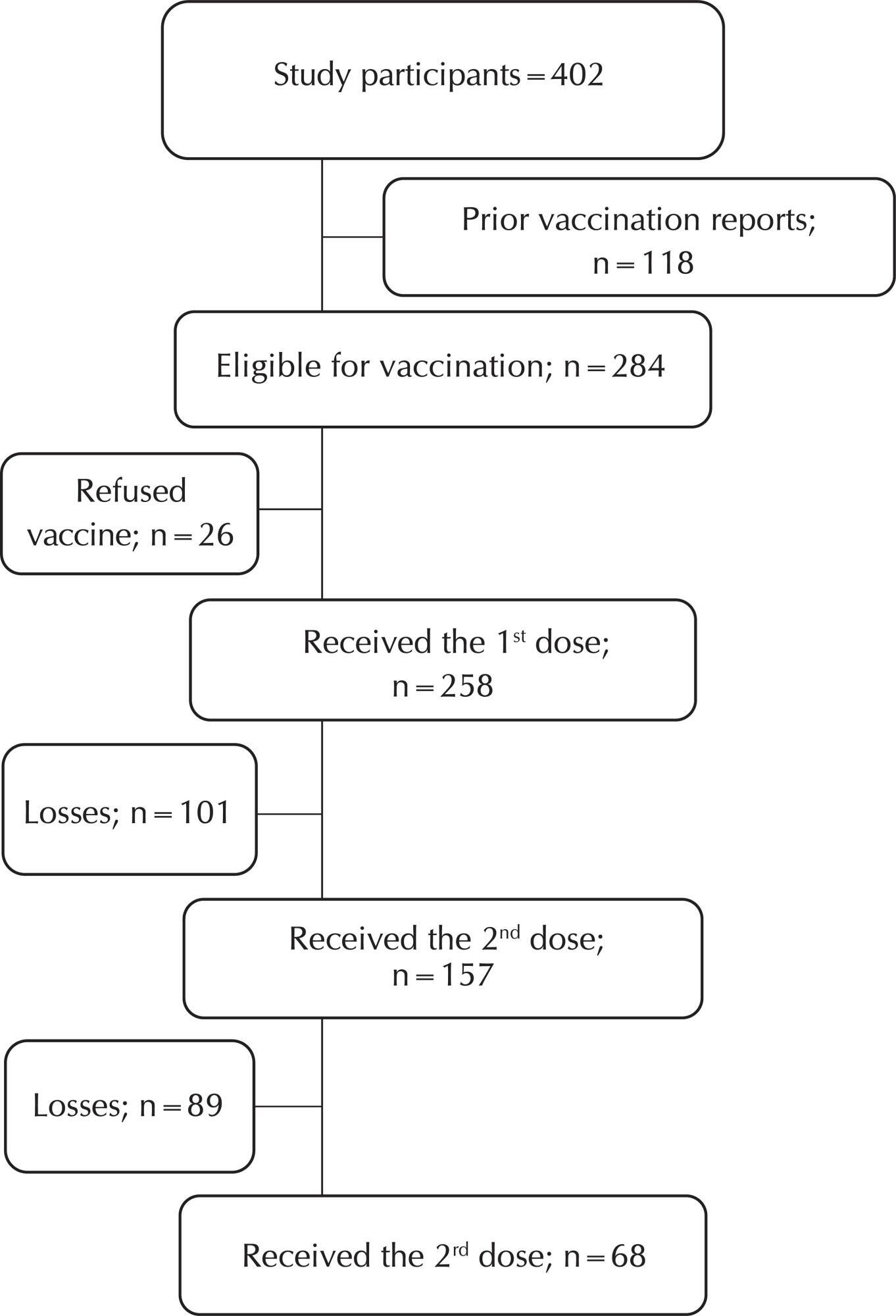
-
RESEARCH01-01-2017
Cost of nursing most frequent procedures performed on severely burned patients
Revista Brasileira de Enfermagem. 2017;70(3):481-488
Abstract
RESEARCHCost of nursing most frequent procedures performed on severely burned patients
Revista Brasileira de Enfermagem. 2017;70(3):481-488
DOI 10.1590/0034-7167-2015-0034
Views0See moreABSTRACT
Objective:
to identify the mean direct cost (MDC) of the most frequent procedures performed by nursing professionals on severely burned patients in an Intensive Care Unit.
Method:
exploratory-descriptive quantitative single-case study. The MDC was calculated by multiplying time (timed) spent by nursing professionals in the performance of the procedures by the unit cost of direct labor, and adding the costs of material and medicine/solutions.
Results:
a MDC of US$ 0.65 (SD=0.36) was obtained for “vital signs monitoring”; US$ 10.00 (SD=24.23) for “intravenous drug administration”; US$ 5.90 (SD=2.75) for “measurement of diuresis”; US$ 0.93 (SD=0.42) for “capillary blood glucose monitoring”; and US$ 99.75 (SD=129.55) for “bandaging”.
Conclusion:
the knowledge developed can support managerial decision-making, contribute to the efficiency distribution of the resources involved and, when possible, provide cost-containment or cost-minimization strategies without impairing the quality of nursing care.
-
RESEARCH01-01-2017
Nursing Activities Score and Acute Kidney Injury
Revista Brasileira de Enfermagem. 2017;70(3):475-480
Abstract
RESEARCHNursing Activities Score and Acute Kidney Injury
Revista Brasileira de Enfermagem. 2017;70(3):475-480
DOI 10.1590/0034-7167-2016-0266
Views0See moreABSTRACT
Objective:
to evaluate the nursing workload in intensive care patients with acute kidney injury (AKI).
Method:
A quantitative study, conducted in an intensive care unit, from April to August of 2015. The Nursing Activities Score (NAS) and Kidney Disease Improving Global Outcomes (KDIGO) were used to measure nursing workload and to classify the stage of AKI, respectively.
Results:
A total of 190 patients were included. Patients who developed AKI (44.2%) had higher NAS when compared to those without AKI (43.7% vs 40.7%), p <0.001. Patients with stage 1, 2 and 3 AKI showed higher NAS than those without AKI. A relationship was identified between stage 2 and 3 with those without AKI (p = 0.002 and p <0.001).
Conclusion:
The NAS was associated with the presence of AKI, the score increased with the progression of the stages, and it was associated with AKI, stage 2 and 3.
-
RESEARCH01-01-2017
Nursing appointment and cardiometabolic control of diabetics: a randomized clinical trial
Revista Brasileira de Enfermagem. 2017;70(3):468-474
Abstract
RESEARCHNursing appointment and cardiometabolic control of diabetics: a randomized clinical trial
Revista Brasileira de Enfermagem. 2017;70(3):468-474
DOI 10.1590/0034-7167-2016-0352
Views0See moreABSTRACT
Objective:
to verify the effect of nursing appointment on cardiometabolic profile of people with Diabetes Mellitus type 2.
Method:
randomized controlled trial, developed with 134 individuals chosen for two groups: intervention and control. The intervention consisted of three nursing appointments alternated bimonthly, with two phone calls, over five months. The control group received usual care offered by the Health Unit. Data were collected through semi-structured interviews before and after the intervention, in addition to conducting laboratory tests.
Results:
after the intervention, a significant difference was shown in the amount of glycated hemoglobin (p = 0.006) and in the systolic blood pressure (p = 0.031), which were higher in the control group.
Conclusion:
besides being low-cost and easy to develop on the monitoring routine of people with diabetes, the intervention performed influenced positively the biochemical profile.
-
RESEARCH01-01-2017
Terms of the specialized nursing language for the care of ostomates
Revista Brasileira de Enfermagem. 2017;70(3):461-467
Abstract
RESEARCHTerms of the specialized nursing language for the care of ostomates
Revista Brasileira de Enfermagem. 2017;70(3):461-467
DOI 10.1590/0034-7167-2015-0058
Views0See moreABSTRACT
Objectives:
to identify terms of the specialized nursing language for the care of ostomates from the literature of the area, and to map the identified terms with terms of the International Classification for Nursing Practice (ICNP®).
Method:
descriptive study of quantitative approach guided by the guidelines for the elaboration of terminology subsets of the ICNP®. The terms were collected in 49 scientific articles, extracted using a computational tool, selected according to the relevance for the theme, and normalized and mapped with the ICNP®.
Results:
20,668 terms were extracted. The standardization process resulted in 425 relevant terms (151 were constant in ICNP® and 274 were not contained in ICNP®), of which 154 were similar, 19 were more comprehensive, 50 were more restricted, and 51 were not in concordance.
Conclusion:
the use of standardized language can minimize the ambiguities and redundancies identified in the mapping. The existence of terms not in concordance with the ICNP® reinforces the need for constant updating of this classification.
-
REVIEW06-10-2022
Self-inflicted violence and suicide in people living with HIV/AIDS: a systematic review
Revista Brasileira de Enfermagem. 2022;75:e20210768
Abstract
REVIEWSelf-inflicted violence and suicide in people living with HIV/AIDS: a systematic review
Revista Brasileira de Enfermagem. 2022;75:e20210768
DOI 10.1590/0034-7167-2021-0768
Views0See moreABSTRACT
Objectives:
to analyze intellectual productions on self-inflicted violence and suicide in people living with HIV/AIDS.
Methods:
a systematic review, carried out between March and April 2021, in the PubMed®/MEDLINE®, Web of Science and LILACS databases, subsidized in the Strengthening the Reporting of Observational Studies in Epidemiology. The period outlined was from 2011 to 2020.
Results:
a total of 199 studies were identified, and 16 composed the final sample, grouped into the categories: Sociodemographic characteristics of victims of self-inflicted violence/suicide and their intervening factors (pointing to young adults, especially homosexuals, with low social support and a history of mental illness or substance abuse as usual victims); Successful measures for suicide prevention/control in people living with HIV/AIDS (suggesting more frequent psychosocial and clinical follow-up of those starting antiretroviral and immunocompromised treatment).
Conclusions:
biopsychosocial follow-up, analysis of sociodemographic profile and intervening factors should be frequent in this population for disease prevention/control.

-
ORIGINAL ARTICLE09-05-2022
Screening for common mental disorder in elderly residents in the countryside: a cross-sectional study
Revista Brasileira de Enfermagem. 2022;75:e20210875
Abstract
ORIGINAL ARTICLEScreening for common mental disorder in elderly residents in the countryside: a cross-sectional study
Revista Brasileira de Enfermagem. 2022;75:e20210875
DOI 10.1590/0034-7167-2021-0875
Views0See moreABSTRACT
Objective:
To estimate the prevalence of common mental disorders and their associated factors in the elderly in a municipality in the countryside of the Brazilian Midwest.
Methods:
Quantitative, observational, cross-sectional approach research, conducted with 218 elderly people.
Results:
The prevalence of the common mental disorder among the elderly was 25.1%; in the univariate analysis, it was higher in females (35.4%), in the age group of 80 years or older (46.1%), brown skin color (30.2%), widowed (42.6%), illiterate (47.6%), and retired (27.6%). In the multiple analysis, the variables female gender (p<0.006), age 80 years or older (p<0.036), dissatisfaction with life (p<0.009), lack of social interaction (p=0.017), and dysfunctional family (p=0.021) remained associated with CMD.
Conclusion:
The results revealed are helpful and contribute to the reinforcement of the need for mental health care in this population extract so growing worldwide.
-
ORIGINAL ARTICLE06-03-2022
Association between falls in older adults and prevention group
Revista Brasileira de Enfermagem. 2022;75:e20200207
Abstract
ORIGINAL ARTICLEAssociation between falls in older adults and prevention group
Revista Brasileira de Enfermagem. 2022;75:e20200207
DOI 10.1590/0034-7167-2020-0207
Views0See moreABSTRACT
Objectives:
to assess the effectiveness of guidelines on fall prevention in a group of older adults in Primary Health Care.
Methods:
a cross-sectional study, carried out with older adults selected by a simple random sample (274; N=1,234). Data covered sociodemographic and socioeconomic variables, marital status, health conditions, factors associated with falls and participation in the prevention group. Student’s t test was used, and dichotomous variables were used by the chi-square test. The project met ethical requirements.
Results:
sample with female profile (61.7%), married, with low education, mean age of 71.69 years. The factors associated with falls identified were female sex, medicalization and participation in the prevention group. There was no protective association between participation in a fall prevention group in older adults and a decrease in the number of falls.
Conclusions:
based on evidence, a personalized intervention during the nursing visit is suggested as a strategy to prevent falls.

-
ORIGINAL ARTICLE03-07-2022
Predictors of frailty in older people users of Primary Health Care
Revista Brasileira de Enfermagem. 2022;75:e20201292
Abstract
ORIGINAL ARTICLEPredictors of frailty in older people users of Primary Health Care
Revista Brasileira de Enfermagem. 2022;75:e20201292
DOI 10.1590/0034-7167-2020-1292
Views0See moreABSTRACT
Objective:
to identify the prevalence and predictors of frailty in older people in Primary Health Care.
Method:
this is a descriptive and correlational study, carried out in a convenience sample of 136 older people in the community. Data were collected through a sociodemographic and clinical questionnaire and frailty phenotype. Student’s t test or U-Mann-Whitney test, chi-square and binary logistic regression were used for data analysis.
Results:
the prevalence of frailty was 26.5% (n=36). Frail individuals had older age (p=0.011), worse self-rated health (p=0.001) and lower physical capacity (p<0.001). In the multivariable regression, it was observed that frail individuals had older age (Odds Ratio=1.111; 95% confidence interval=1.026-1.203) and worse physical capacity (Odds Ratio=0.673; 95% confidence interval=0.508-0.893).
Conclusions:
the prevalence of frailty in older people in Primary Health Care was considerable. Advanced age and worse physical capacity were the most relevant predictors of frailty in the elderly.
-
ORIGINAL ARTICLE04-15-2022
Validation of Questionnaire to Assess the Impact of Dementia on the Family
Revista Brasileira de Enfermagem. 2022;75:e20210232
Abstract
ORIGINAL ARTICLEValidation of Questionnaire to Assess the Impact of Dementia on the Family
Revista Brasileira de Enfermagem. 2022;75:e20210232
DOI 10.1590/0034-7167-2021-0232
Views0See moreABSTRACT
Objective:
To validate a questionnaire to assess the impact of dementia on one of the household members.
Methods:
Methodological study. The instrument was designed based on literature review, expert opinion, and researchers’ experience and then applied to a non-probability convenience sample consisting of 262 family members who live daily with a person with dementia. The construct validity was studied by exploratory factor analysis, principal components method, with varimax rotation of the items.
Results:
An instrument with 30 items was obtained, distributed in four dimensions: “Emotional dimension,” “Economic dimension,” “Family relations dimension,” and “Support-seeking dimension.” Factor analysis revealed a total explained variance of 54.96% and a total Cronbach’s alpha of .899.
Conclusions:
The instrument presents high internal consistency, grouped into four dimensions, all closely related to the family’s adaptation to the onset of dementia in one of its members.
-
ORIGINAL ARTICLE03-07-2022
Is self-esteem associated with the elderly person’s quality of life?
Revista Brasileira de Enfermagem. 2022;75:e20210388
Abstract
ORIGINAL ARTICLEIs self-esteem associated with the elderly person’s quality of life?
Revista Brasileira de Enfermagem. 2022;75:e20210388
DOI 10.1590/0034-7167-2021-0388
Views0See moreABSTRACT
Objective:
To analyze the association between self-esteem and quality of life in the elderly.
Methods:
Cross-sectional web survey developed with 519 elderly people. Participants filled out three data collection instruments developed on the Google Forms platform and widely disseminated through all of Brazil. Fisher’s exact test, Mann-Whitney, Pearson correlation, and linear regression with 95% confidence interval were used.
Results:
Self-esteem was associated with all quality-of-life facets: sensory skills [β= 1.307; p<0.001]; autonomy [β= 2.101; p<0.001]; past, present, and future activities [β= 2.486; p<0.001]; social presence [β= 2.547; p<0.001]; death and dying [β= 2.175; p<0.001]; and intimacy [β=2.378; p<0.001].
Conclusion:
There is a positive and statistically significant association between self-esteem and quality of life in the elderly. We therefore suggest the development of local policies capable of raising this age groups’ self-esteem and reaffirming aging as a new possibility for discoveries and pleasure.
-
EXPERIENCE REPORT10-24-2022
Nursing process for elderly women susceptible to falls from the perspective of the Pender’s Model
Revista Brasileira de Enfermagem. 2022;75:e20210913
Abstract
EXPERIENCE REPORTNursing process for elderly women susceptible to falls from the perspective of the Pender’s Model
Revista Brasileira de Enfermagem. 2022;75:e20210913
DOI 10.1590/0034-7167-2021-0913
Views0See moreABSTRACT
Objectives:
to describe the strategy of applying the nursing process guided by Pender’s Health Promotion Model to elderly women susceptible to falls with a view to promoting a self-efficacy behavior for fall prevention.
Methods:
application of the nursing process to eleven elderly women who had already experienced falls, living in a neighborhood in the outskirts of Belem, state of Pará, which involved interviews to obtain their nursing history and group meetings using the focus group technique to develop the other phases of the nursing process: nursing diagnosis, nursing interventions, and nursing assessment.
Results:
despite the risk factors for falls, the intervention model adopted in this study allowed elderly women to enhance their self-efficacy.
Final Considerations:
the model proved to be suitable for the participation of elderly women in actions to build fall prevention behaviors, with a view to healthier lifestyles.

-
ORIGINAL ARTICLE10-24-2022
Factors associated with symptoms of physical and emotional burden in informal caregivers of the elderly
Revista Brasileira de Enfermagem. 2022;75:e20210927
Abstract
ORIGINAL ARTICLEFactors associated with symptoms of physical and emotional burden in informal caregivers of the elderly
Revista Brasileira de Enfermagem. 2022;75:e20210927
DOI 10.1590/0034-7167-2021-0927
Views1See moreABSTRACT
Objectives:
to analyze the personal and work-related burden factors associated with physical and emotional symptoms of informal caregivers of the elderly.
Methods:
cross-sectional study conducted with 121 informal caregivers and 121 seniors who received care, assessed individually for the risk of: physical overload, musculoskeletal symptoms, Self-Reporting Questionnaire, effort perception, and Katz index.
Results:
a greater perception of effort raises up to 3.3 times the chances of presenting symptoms of pain in the spine region (p=0.01), and lower functional capacity of the elderly increases up to 1.3 times the chances of presenting pain symptoms in the spine region (p=0.02). The symptoms of emotional overload were associated with the caregiver’s low income (p=0.02).
Conclusions:
the perception of effort, dependence of the elderly, caregiver’s age, and symptoms of emotional overload are involved with caregivers’ symptoms of physical overload, and low income, with emotional overload.
-
ORIGINAL ARTICLE08-19-2019
Mobile application for the teaching of the International Classification for Nursing Practice
Revista Brasileira de Enfermagem. 2019;72(4):1020-1027
Abstract
ORIGINAL ARTICLEMobile application for the teaching of the International Classification for Nursing Practice
Revista Brasileira de Enfermagem. 2019;72(4):1020-1027
DOI 10.1590/0034-7167-2018-0751
Views0See moreABSTRACT
Objective:
Developing a mobile application for the teaching of the International Classification for Nursing Practice.
Methods:
Methodological applied research for technological production, performed in three phases of the contextualized instructional design model: analysis, design and development.
Results:
The application has an initial screen, which provides information about the team and its purpose. Then, four moblets are listed, including presentation, user’s guide consisting of five modules, educational games and five clinical cases. The references on which the application was based are also presented.
Final considerations:
It was possible to develop an application with the potential to promote the knowledge of nursing students and professionals about this classification system.
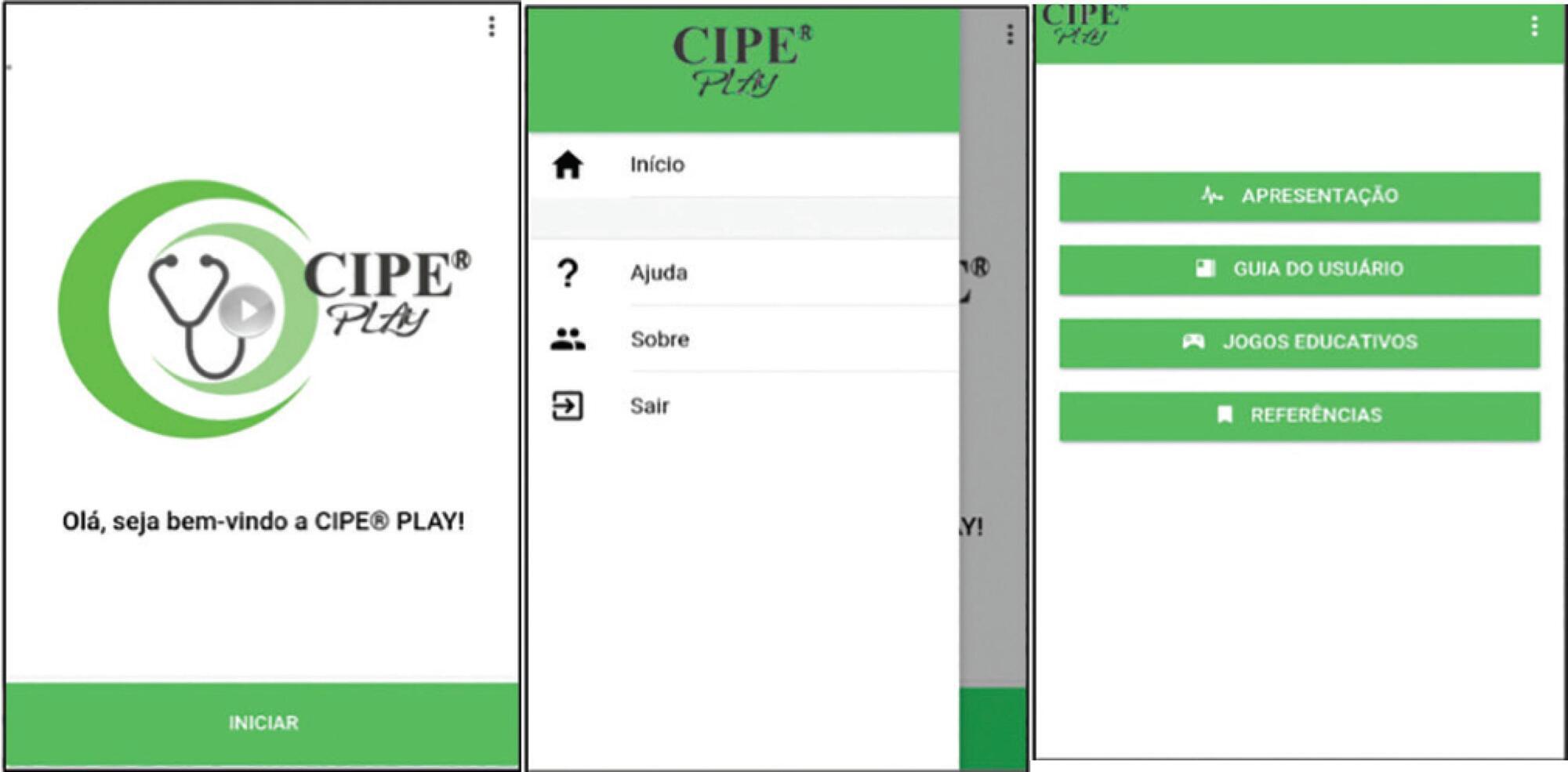
-
ORIGINAL ARTICLE08-14-2020
Education to prevent ventilator-associated pneumonia in intensive care unit
Revista Brasileira de Enfermagem. 2020;73(6):e20190477
Abstract
ORIGINAL ARTICLEEducation to prevent ventilator-associated pneumonia in intensive care unit
Revista Brasileira de Enfermagem. 2020;73(6):e20190477
DOI 10.1590/0034-7167-2019-0477
Views0INTRODUCTIONVentilator-Associated Pneumonia (VAP) is one of the complications related to the care of patients hospitalized in the Intensive Care Unit (ICU), which, according to consulted authors, exceeds the mortality rates of other Healthcare Related Infections (HRI). VAP is the second most frequent infection in patients admitted to the ICU, as well as the most prevalent […]See more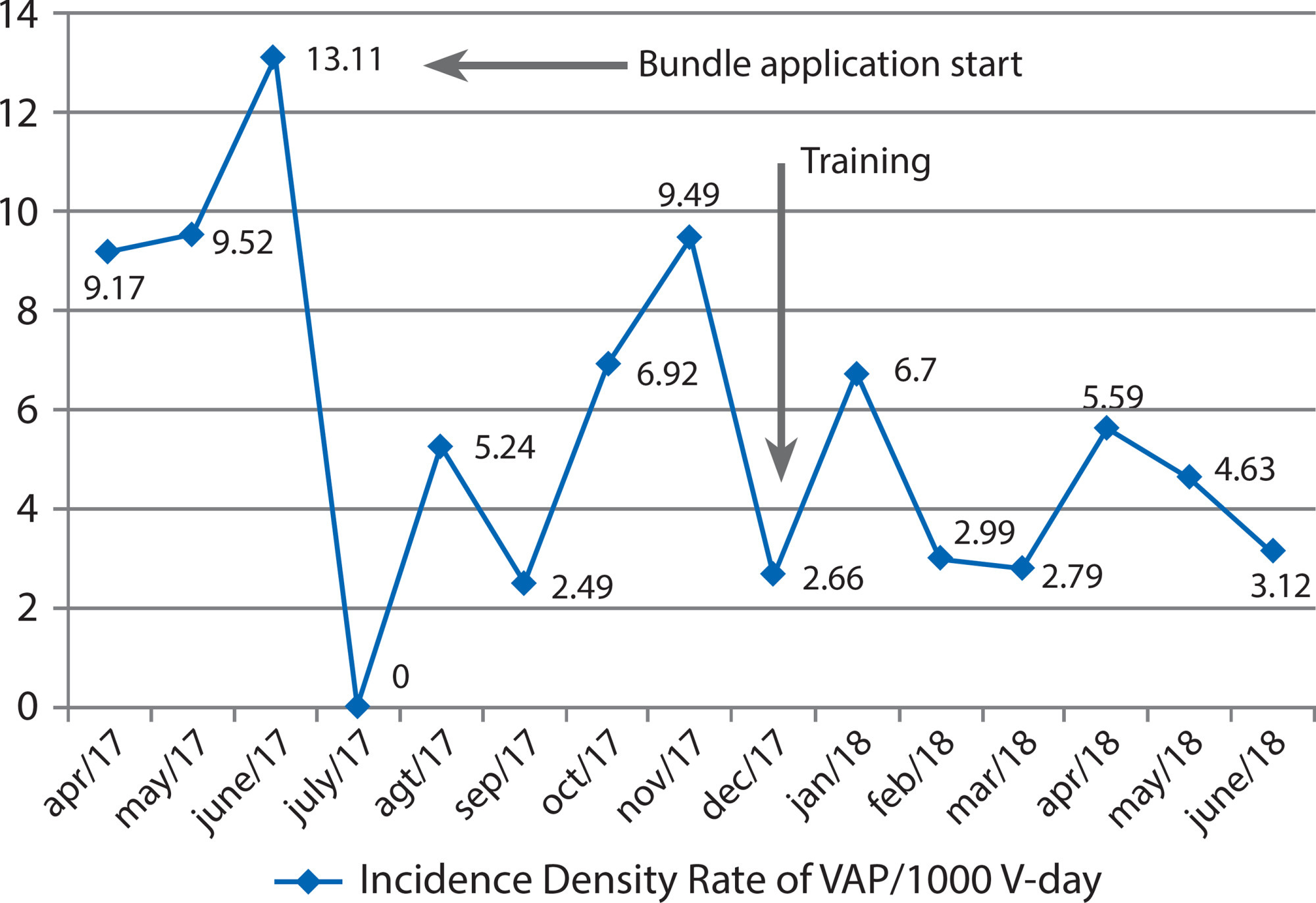
-
08-19-2019
Degree in Nursing: education through problem-based learning
Revista Brasileira de Enfermagem. 2019;72(4):1071-1077
Abstract
Degree in Nursing: education through problem-based learning
Revista Brasileira de Enfermagem. 2019;72(4):1071-1077
DOI 10.1590/0034-7167-2018-0298
Views0See moreABSTRACT
Objective:
To describe how undergraduate courses in Nursing are using the problem-based learning (PBL).
Method:
Integrative literature review, from searches in the databases Education Resources Information Center (ERIC), Latin American and Caribbean Health Sciences Literature (Lilacs), and PubMed, from 2010 to 2015. 36 articles were analyzed.
Results:
A teaching method used in all continents, the PBL enables improvement of the critical thinking, autonomy, motivation for learning, active search attitude, ability to work in teams, and problem-solving. Difficulties and challenges relate to the training of students and teachers to understand the principles of the method.
Final considerations:
The benefits of PBL coincide with the needs of nursing training, but its applicability demands constant review in seeking to develop the skills necessary for this training.
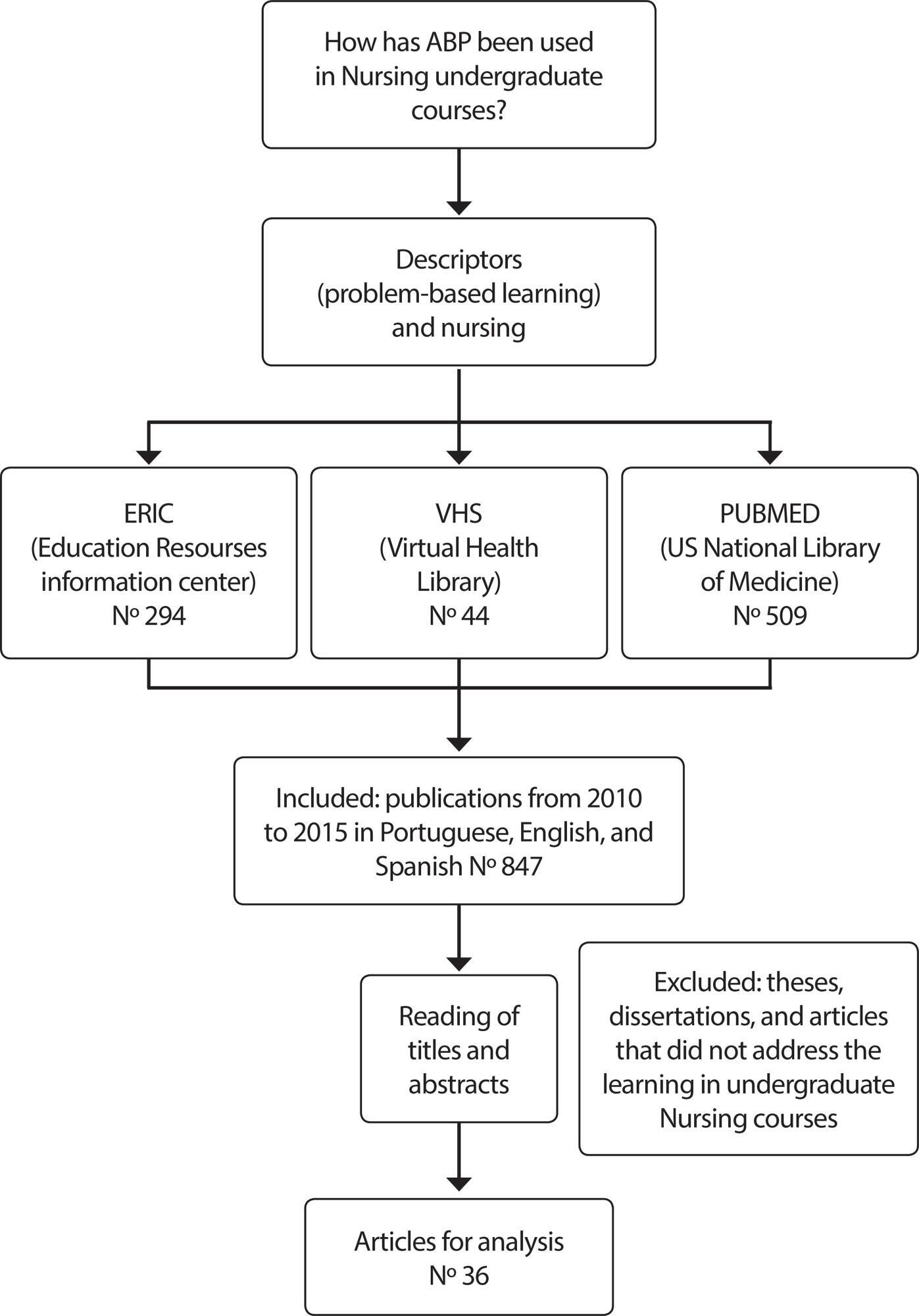
-
ORIGINAL ARTICLE12-13-2019
Mobile health technology for gestational care: evaluation of the GestAção’s app
Revista Brasileira de Enfermagem. 2019;72:266-273
Abstract
ORIGINAL ARTICLEMobile health technology for gestational care: evaluation of the GestAção’s app
Revista Brasileira de Enfermagem. 2019;72:266-273
DOI 10.1590/0034-7167-2018-0641
Views0See moreABSTRACT
Objective:
to evaluate the GestAção application, based on the experience of pregnant women use.
Method:
an evaluative, applied, methodological, quantitative-qualitative study. This tool was evaluated by 13 pregnant women through questionnaires for sociodemographic profile characterization and Likert scale use to calculate Content Validity Index (CVI); and semi-structured interview, with analysis based on Semiotics.
Results:
the study evidenced a significant level of satisfaction of pregnant women with the application use, considering the objectives (CVI = 0.92), structure and presentation (CVI = 0.86), and relevance (CVI = 0.92).
Final considerations:
the GestAção application obtained an overall CVI of 0.90, evidencing it as a facilitating and supporting technology in the empowerment of pregnant women interested in obtaining knowledge about pregnancy. It has been proved to be a powerful tool to qualify good practices in nursing consultation.
-
REFLECTION06-29-2020
Children’s (in)visibility in social vulnerability and the impact of the novel coronavirus (COVID-19)
Revista Brasileira de Enfermagem. 2020;73:e20200302
Abstract
REFLECTIONChildren’s (in)visibility in social vulnerability and the impact of the novel coronavirus (COVID-19)
Revista Brasileira de Enfermagem. 2020;73:e20200302
DOI 10.1590/0034-7167-2020-0302
Views0See moreABSTRACT
Objective:
To examine the impact of the infection by the novel coronavirus on Brazilian children in situation of social vulnerability based on the Millennium Sustainable Development Goals.
Method:
Reflective study based on discursive formulation in three aspects: principles of the objectives and goals for the millennium sustainable development; impact of the pandemic on the health of children and their families living in social vulnerability; and the role of pediatric nursing in the care provided – limits and challenges.
Results:
In January 2020, the news of COVID 19 is released as a pandemic. In Brazil, children and families are still without access to basic rights, thereby increasing their risks of social vulnerability because of the quarantine. The nursing field has an important role in monitoring children and their families, offering guidance in search for solutions and preventing contamination.
Conclusion:
There are still challenges to be overcome by the children and their families in situations of vulnerability against COVID-19.
-
ORIGINAL ARTICLE07-10-2020
Profile of nursing students: quality of life, sleep and eating habits
Revista Brasileira de Enfermagem. 2020;73:e20190365
Abstract
ORIGINAL ARTICLEProfile of nursing students: quality of life, sleep and eating habits
Revista Brasileira de Enfermagem. 2020;73:e20190365
DOI 10.1590/0034-7167-2019-0365
Views0See moreABSTRACT
Objective:
to profile and analyze sleep quality, quality of life and eating habits of nursing students.
Methods:
a cross-sectional, comparative and correlational study with the following variables: sociodemographic characteristics, Pittsburgh sleep quality index, quality of life and eating habits. One hundred ninety-five students participated in the study.
Results:
participants were on average 24 years old. Results showed that females were prevalent (87.1%); 71.0% of the students had poor sleep quality; 98.9% used electronic devices before bedtime. Self-perception of quality of life was indifferent (38.3%), and self-perception of general health, 36.9% expressed satisfaction. Among the participants, 45.13% consumed one portion of fruit and 40.66% two to three portions of vegetables daily.
Conclusion:
the study allowed the profile of these students, sedentary, overweight and poor sleep quality young students who studied and worked.
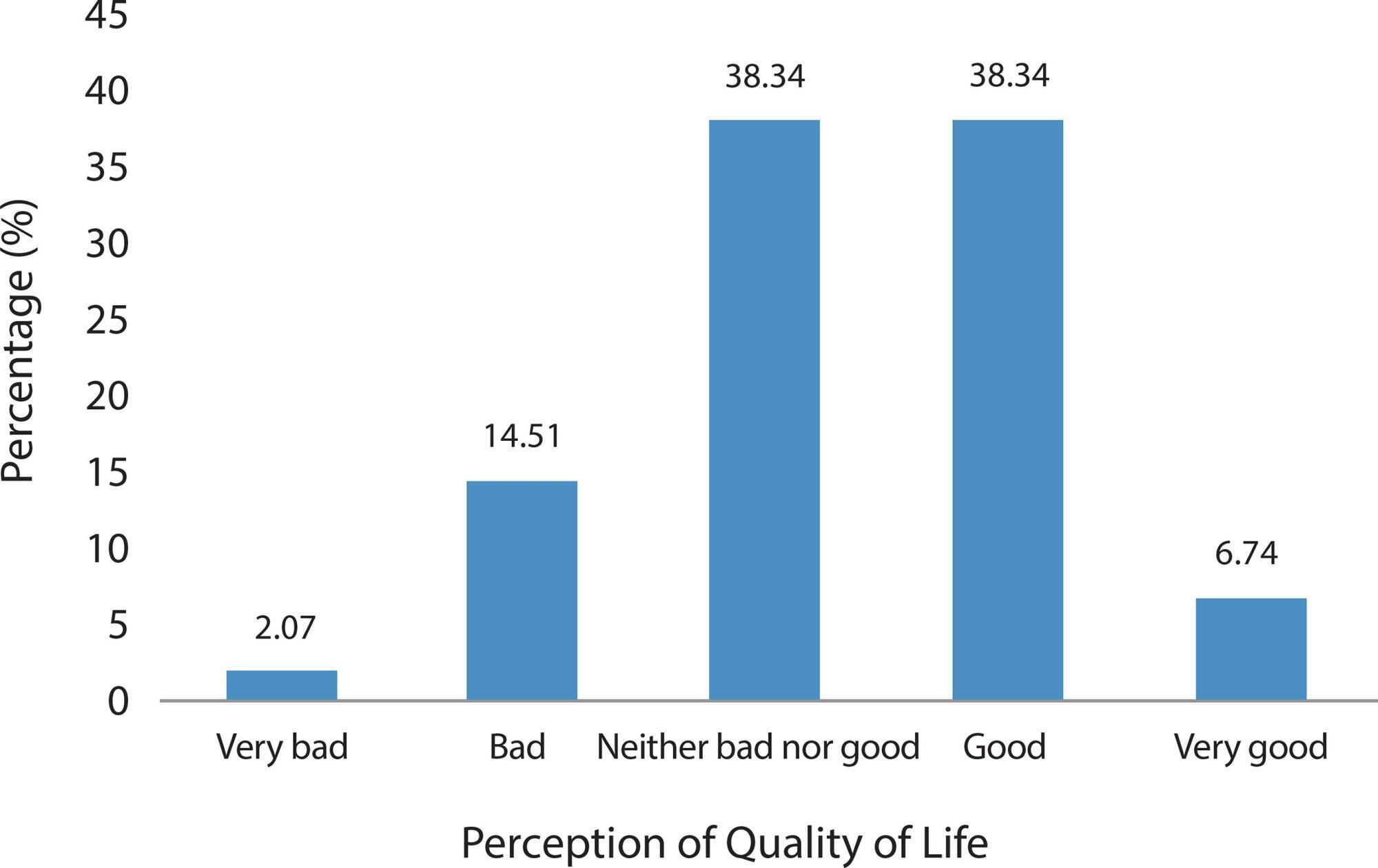
-
ORIGINAL ARTICLE06-09-2020
Stress of nursing professionals working in pre-hospital care
Revista Brasileira de Enfermagem. 2020;73(2):e20180660
Abstract
ORIGINAL ARTICLEStress of nursing professionals working in pre-hospital care
Revista Brasileira de Enfermagem. 2020;73(2):e20180660
DOI 10.1590/0034-7167-2018-0660
Views0See moreABSTRACT
Objectives:
To analyze the factors related to the occupational stress of a Mobile Emergency Care Service (Samu) nursing team.
Methods:
This is a descriptive study, with a quantitative approach, performed with nursing professionals from Samu service of a city of Pernambuco. A sociodemographic questionnaire and the Lipp’s Stress Symptom Inventory were used.
Results:
The participants presenting stress (24.6%) were classified in the phases: resistance (19.7%), exhaustion (4.4%) and near exhaustion (0.5%). It was also observed an association of stress level with the following factors: gender, sleep quality, professional autonomy restriction, emotional exhaustion with work performed and work in inadequate or unhealthy physical facilities.
Conclusions:
Although showing low occurrence of stress, this study pointed out the profile that presents the highest risk of developing occupational stress, through the factors significantly associated with stress in the studied population.
-
ORIGINAL ARTICLE07-10-2020
Nursing appeals on social media in times of coronavirus
Revista Brasileira de Enfermagem. 2020;73:e20200225
Abstract
ORIGINAL ARTICLENursing appeals on social media in times of coronavirus
Revista Brasileira de Enfermagem. 2020;73:e20200225
DOI 10.1590/0034-7167-2020-0225
Views0See moreABSTRACT
Objective:
to know and analyze the nursing appeals on social media during the COVID-19 pandemic.
Method:
it is a documentary, qualitative, descriptive, and exploratory research with data collected in publications in two social media. Two hundred ninety-five publications of nursing professionals published on Twitter and Instagram between March 11 and 20, 2020 were submitted to content analysis using ATLAS.ti resources.
Results:
four thematic categories emerged: #stayathome, #whereismyPPE, #nowweareheroes, #nothingnewinthefrontline, according to frequency of communications. The appeals show a relationship with the social relevance of nursing professional work and with the conditions required for its exercise.
Final considerations:
old and new challenges of the profession were placed on the agenda in social media, especially related to the workforce and instruments of labor. These speeches can serve as a foundation for policies to improve working conditions and promote appreciation of the profession.

Search
Search in:
Nuvem de Tags
Adolescente (85) Atenção Primária à Saúde (239) COVID-19 (91) Criança (91) Cuidados de Enfermagem (269) Educação em Enfermagem (151) Educação em Saúde (139) Enfermagem (930) Enfermagem Pediátrica (86) Estudantes de Enfermagem (77) Estudos de Validação (131) Família (87) Idoso (208) Promoção da Saúde (99) Qualidade de Vida (104) Saúde do Trabalhador (86) Saúde Mental (145) Saúde Pública (82) Segurança do Paciente (150) Tecnologia Educacional (100)



